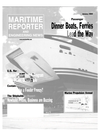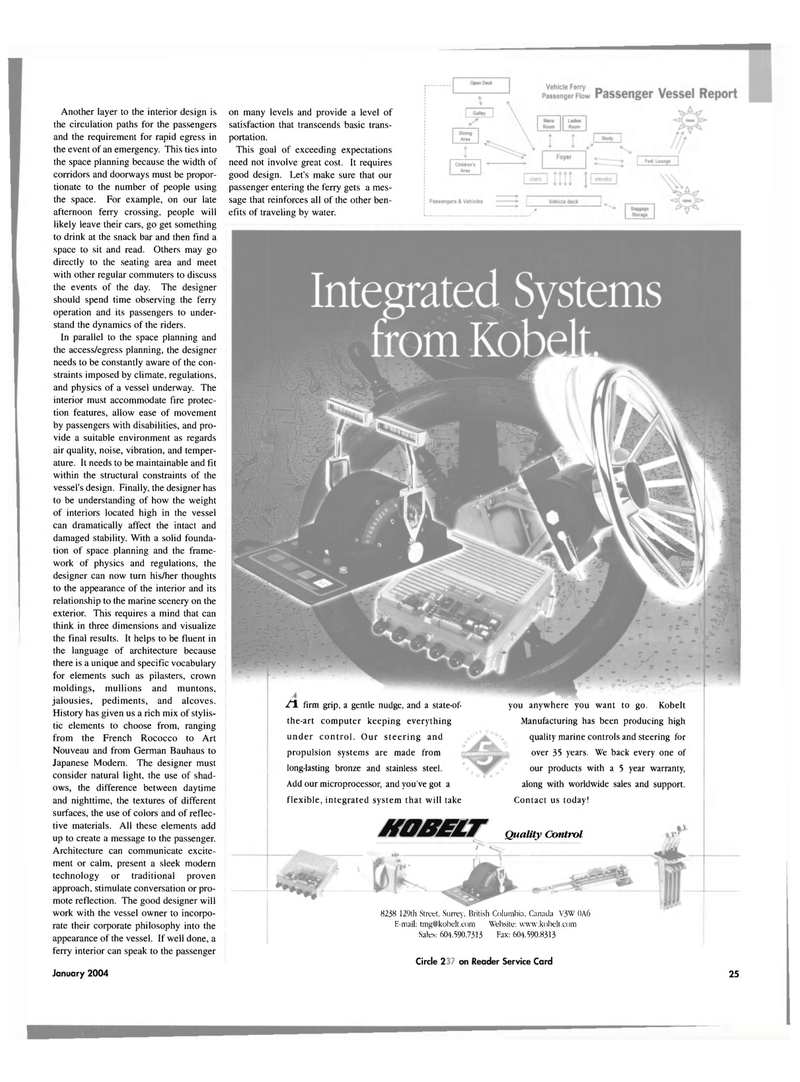
Page 25: of Maritime Reporter Magazine (January 2004)
Ferry & Passenger Vessel Yearbook
Read this page in Pdf, Flash or Html5 edition of January 2004 Maritime Reporter Magazine
Another layer to the interior design is the circulation paths for the passengers and the requirement for rapid egress in the event of an emergency. This ties into the space planning because the width of corridors and doorways must be propor- tionate to the number of people using the space. For example, on our late afternoon ferry crossing, people will likely leave their cars, go get something to drink at the snack bar and then find a space to sit and read. Others may go directly to the seating area and meet with other regular commuters to discuss the events of the day. The designer should spend time observing the ferry operation and its passengers to under- stand the dynamics of the riders.
In parallel to the space planning and the access/egress planning, the designer needs to be constantly aware of the con- straints imposed by climate, regulations, and physics of a vessel underway. The interior must accommodate fire protec- tion features, allow ease of movement by passengers with disabilities, and pro- vide a suitable environment as regards air quality, noise, vibration, and temper- ature. It needs to be maintainable and fit within the structural constraints of the vessel's design. Finally, the designer has to be understanding of how the weight of interiors located high in the vessel can dramatically affect the intact and damaged stability. With a solid founda- tion of space planning and the frame- work of physics and regulations, the designer can now turn his/her thoughts to the appearance of the interior and its relationship to the marine scenery on the exterior. This requires a mind that can think in three dimensions and visualize the final results. It helps to be fluent in the language of architecture because there is a unique and specific vocabulary for elements such as pilasters, crown moldings, mullions and muntons, jalousies, pediments, and alcoves.
History has given us a rich mix of stylis- tic elements to choose from, ranging from the French Rococco to Art
Nouveau and from German Bauhaus to
Japanese Modern. The designer must consider natural light, the use of shad- ows, the difference between daytime and nighttime, the textures of different surfaces, the use of colors and of reflec- tive materials. All these elements add up to create a message to the passenger.
Architecture can communicate excite- ment or calm, present a sleek modern technology or traditional proven approach, stimulate conversation or pro- mote reflection. The good designer will work with the vessel owner to incorpo- rate their corporate philosophy into the appearance of the vessel. If well done, a ferry interior can speak to the passenger on many levels and provide a level of satisfaction that transcends basic trans- portation.
This goal of exceeding expectations need not involve great cost. It requires good design. Let's make sure that our passenger entering the ferry gets a mes- sage that reinforces all of the other ben- efits of traveling by water. /I firm grip, a gentle nudge, and a state-of- the-art computer keeping everything under control. Our steering and propulsion systems are made from long-lasting bronze and stainless steel.
Add our microprocessor, and you've got a flexible, integrated system that will take you anywhere you want to go. Kobelt
Manufacturing has been producing high quality marine controls and steering for over 35 years. We back every one of our products with a 5 year warranty, along with worldwide sales and support.
Contact us today! 8238 129th Street, Surrey, British Columbia, Canada V3W 0A6
E-mail: [email protected] Website: w ww.kobelt.com
Sales: 604.590.7313 Fax: 604.590.8313
JiOBELT Quality Control
Circle 260 on Reader Service Card
January 2004 25

 24
24

 26
26
